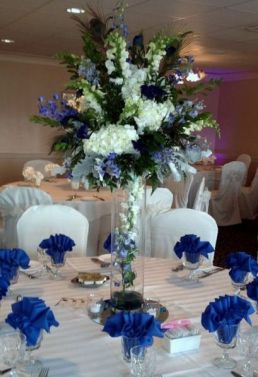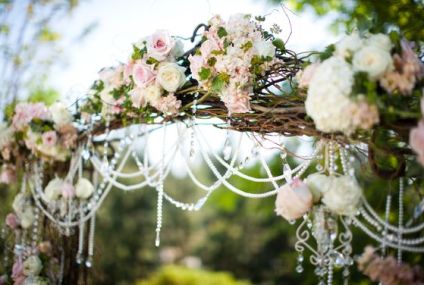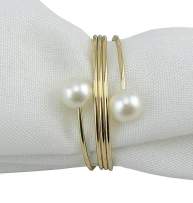
In this post about the ongoing series about TV weddings, I will discuss the epic wedding of Jamie and Claire Fraser in the popular Starz television series. I will include a description of Claire’s stunning wedding dress and Jamie’s tartan kilt as well as the sentimental wedding ring and the Scottish pearl necklace that Jamie gave to Claire. (I know I’m about six years too late for this trend but I have recently enjoyed binge watching all the episodes from the past seasons!)
Special Note: The Outlander wedding is the perfect inspiration for a destination wedding to Scotland or for a bridal couple that want to incorporate their Scottish heritage into the wedding.
The Outlander Series
The Outlander series on the Starz cable television network premiered in August 2014. The series is based on the historical fantasy novels by Diana Gabaldon. The first book was published in 1991 and to date eight of the planned ten books in the series have been published.
The first season of Outlander centers on the main character Claire Beauchamp Randall (played by Caitriona Balfe) who is a former World War II nurse married to Frank Randall (played by Tobias Menzies). The couple is staying in Inverness Scotland and through extraordinary circumstances at Craigh Na Dun, the standing stones, Claire time travels to the 18th century where she meets Jamie Fraser (played by Sam Heughan) who is a handsome Highlander.
As she is transported from 1945 to 1743, a bewildered Claire arrives in the Highlands and she is taken into Castle Leoch by the fictional Clan MacKenzie. The Highlanders are suspicious of this mysterious women but Claire is able to gain their trust by using her medical training helping the people living in the area. Meanwhile Jamie and Claire have an unfortunate encounter with the evil Captain “Black Jack” Randall (played by Tobias Menzies in a dual role) and viewers will learn this character is a distant relative of Frank.
Although there is an attraction growing between Jaime and Claire, in an unusual twist of fate, he is forced into marrying her for protection from Captain Jack. Surprisingly Claire enters into the marriage despite the fact that back in 1945 she seems happily married to Frank; as the series progresses the viewers are able to see how he is coping with the sudden disappearance of his wife.
The Wedding of Jamie and Claire Frazer
The wedding of Jamie and Claire takes place in season one episode seven which first aired in September 2014. After the decision is made that Jamie will marry Claire for her protection, the arrangements for the wedding are hastily made. Jaime had three conditions if the marriage was to proceed; one was that the ceremony needed to be performed by a priest in the local church. The second condition is that Claire should receive a special ring that Jamie commissioned from the local blacksmith. The third condition is that Claire is to be married properly and he sends someone out to find a very special dress.
The small church is beautifully lit with candles creating a very romantic setting for the wedding ceremony and the couple exchanges their vows before the priest and a small congregation. Jamie places the specially made ring onto Claire’s right hand, in the book Claire is still wearing Frank’s ring on her left hand but this is changed in the television series. According to ancient custom of handfasting, the wrists of Jamie and Claire are slashed to bleed tied together with a white cloth.


Special Note: all the photos shown in this post are from the Outlander series on Starz
Claire’s Wedding Dress
As Claire approaches the church where the wedding ceremony is to take place, she is wearing a long cape and then just before entering she removes it to reveal a stunning wedding dress. The dress is rather grand in style and might look out of place with all the men and women wearing tartan and homespun dresses. Jamie had send someone to procure a special dress for Claire to wear on her wedding day and the viewers find out that it was previously given to a woman of questionable character as payment of services rendered (if you get my meaning!).
The beautiful wedding dress created by Terry Dresbach and the Outlander costume department took over 3,000 hours to complete and there are so many gorgeous details. The style is reminiscent of a robe de cour and the full skirted dress is made of silver metallic linen with sheer silk smocked sleeves and features an off the shoulder neckline, a boned bodice with a laced back.

The silk stomacher and underskirt are made with mica shavings sewn between two layers of fabric and embellished with silver plate metal hand embroidered on netting with a lovely design of acorn branches and falling leaves.


Special care was also taken by the Outlander costume department to create the underpinnings which were shown in scenes of Claire and Jamie’s wedding night. The items were a simple sheer silk shift, a beautiful laced front strapless stay beautifully embroidered in a floral motif, there is also a laced back, and finally a petticoat with a lovely quilted band at the bottom.



Special Note: There has been some controversy voiced by the fans as to whether Claire’s wedding dress was historically accurate. The opulent style of the wedding dress seems a little out of place given the Scottish Highland location and would be more appropriate befitting a royal palace or a grand ball room. The other issue most frequently commented on by the fans is the low cut neckline which some people think is a little immodest and almost inappropriate to wear in a church setting. My understanding is that there originally was a piece of fabric covering some of the neckline but it was ruined during the reshoots required for filming the episode and was not replaced. Once again, this dress with the extremely low neckline is more in the style of an 18th century European court dress.
Jamie’s Fraser kilt
Although Jaime is living with the fictional Clan MacKenzie, for his wedding day Jaime is wearing a Fraser kilt to honor his heritage. A Scottish tartan was meant to represent a clan and was originally made with alternating colored wool threads woven into a distinctive vertically and horizontal pattern of squares and lines. Historically tartans in the 18th century were woven in more muted colors from natural dyes made with plants or minerals while in modern day Scotland the tartans are more brightly colored.

The main tartan pattern in Outlander is made of brown and blue-grey but there are several variations used throughout the series. The fictional Fraser tartan incorporated thin yellow and red threads into the design and this type of tartan pattern was worn by Jaime on his wedding day. There is an additional tartan pattern with light blue threads woven into the design that is worn by the fictional Mackenzie clan at Castle Leoch.

Special Note: Another sentimental item which is worn by Jaime on his wedding day is his mother’s brooch which he wears on his left shoulder. Not only does the brooch serve a function to hold the tartan in place but it also represents the clan to which a person belongs.

The Wedding Ring
One of the conditions Jaime made before his marriage to Claire was that she would receive a special ring that Jamie commissioned from the local blacksmith. In a very sentimental gesture Jamie had the ring created from a key to his home of Lallybroch, the key is not melted down but forged with “the blade in the bow”.

Special Note: In a very poignant scene at the end of episode seven in season one, Claire dramatically realizes the fact that she had left behind her husband Frank in the 20th century. Just before entering the church to marry Jamie she had removed her wedding ring from Frank and places it in the bodice of her dress. The morning after the wedding to Jamie she finds the ring as it drops out of her wedding dress and it rolls across the floor almost falling through the boards. Perhaps realizing what she has lost in her previous life, she places the ring back on her left hand while wearing the ring from Jamie on her right hand. She looks at her two hands in despair trying to come to terms with the fact that she has two husbands living in different centuries and as a tribute Frank she will continues to wear both rings.

But, there is a sad footnote to Claire’s wedding ring and later in the series it is stolen from her by a sadistic pirate (for some reason he does not take the gold wedding ring from Frank). Claire is truly distraught about losing Jamie’s ring and many years later when they are living in America Jamie has one of his mother’s candlesticks melted down to make a replacement ring for her. Eventually under very dramatic circumstances the original ring given to Claire on her wedding day is ultimately returned to her.
The Pearl Necklace
In the beginning scenes of episode seven in season one of Outlander; Claire says, “Things you cherish and hold dear are like pearls on a string. Cut the knot and they scatter across the floor … never to be found again. So you move on … or at least you try”.
On their wedding night, Jamie gives Claire a gift of his mother’s Scotch pearls. Jamie tells the story that his mother, Ellen MacKenzie, received the necklace on the occasion of her wedding to Brian Fraser. With this sweet and sentimental gesture Claire comes to realize that Jamie is truly a gentle person and her feelings of love for him start to grow stronger.

Scotch pearls are found in freshwater mussels in the rivers of Scotland. Historically this type of irregularly shaped pearls were admired for their luster and collected by royalty, in fact the Crown Jewels of Scotland seen on display at Edinburgh Castle are set with Scotch pearls.
Special Note: Later in the series when Claire returns to the 20th century, Frank is deeply jealous of her life in the past and destroys everything associated with Jamie and her time in the 18th century. Because of this situation Claire has given the Scotch pearl necklace to Mrs. Graham for safekeeping, Mrs. Graham is a trusted friend who believes her story of time travel. Later in the series the necklace will eventually be returned to Claire by Mrs. Graham’s granddaughter. In turn, the Scotch pearl necklace will be given to Claire and Jamie’s daughter on her wedding day.

So, in closing this post, I hope you enjoyed some of the details from the wedding of Jamie and Claire Fraser from the Outlander series. Please check back for a future post about another Outlander wedding of their daughter, Brianna to Roger MacKenzie Wakefield.


 Prince Albert and Princess Alexandra at the time of their engagement
Prince Albert and Princess Alexandra at the time of their engagement












































































 Princess Margaret – the principal bridesmaid at her sister’s wedding
Princess Margaret – the principal bridesmaid at her sister’s wedding




































































